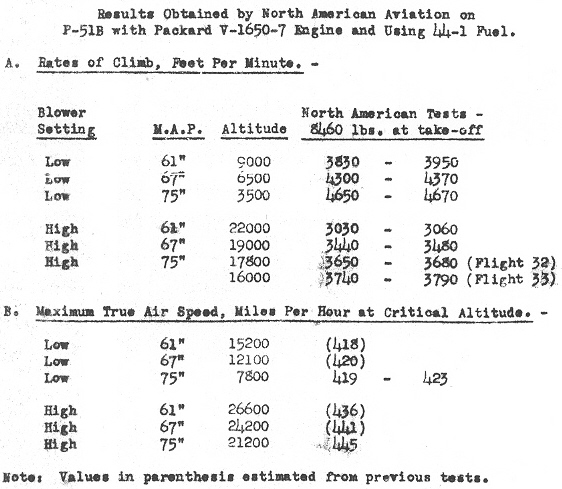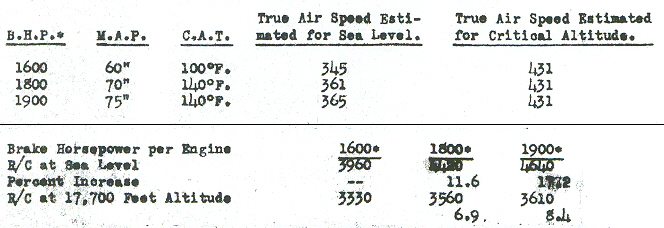|
Into Service with the Royal Air Force
Following successful testing, the Spitfire IX's Merlin 66 was cleared in March 1944 to use +25 lbs, obtainable with 150 grade fuel.
36
In early May, No. 1 and No. 165 Squadrons comprising the Predannack Wing, were the first to convert their Spitfires to +25 lbs boost and employ 150 grade fuel on operations.
37
38
Air Defense Great Britain (A.D.G.B.) shared a report, dated 16th June 1944 with A.E.A.F. summarizing the RAF's experience with using 150 Grade Fuel in Merlin 66 engines.
All pilots reported most favorably on the value of the high boost pressures obtainable with 150 Grade Fuel, however, Technical Staff felt that before the fuel was introduced on a large scale that the causes of backfires must be established and that at least 12 engines should complete 200 hours each.
39
By the end of July the backfires were overcome through fairly straightforward adjustments.
40
By 12 August 1944, 16 Squadrons in A.D.G.B. had been modified to to operate with 150 grade fuel.
41
The increased performance obtained with 150 Grade Fuel was put to good use by Mustangs, Tempests, Spitfires and Mosquitoes in intercepting V-1 Buzz Bombs launched against Britain beginning mid June.
Performance increases at sea level were as follows:
42
43
| | 130 Grade | 150 Grade
| | Spitfire IX | 335 mph | 358 mph +25 lb
| | Spitfire XIV | 359 mph | 366 mph +21 lb
| | Tempest V | 372 mph | 386 mph +11 lb
| | Mustang III (V-1650-3) | 360 mph | 390 mph +25 lb
| | Mosquito NF. Mk. XIX | | 363 mph +25 lb
|
The Royal Aircraft Establishment (RAE) reported in Technical Note No.Aero.1501(Flight) that a Mustang III (Merlin V-1650-7),
flying at +25 lb./sq.in. as received from Squadron, obtained 382 mph at sea level.
44
404 mph was obtained at sea level after "cleaning up" the aircraft by removing the bomb racks and aerial bracket, repainting the wing's leading edge and rubbing down the aircraft.
316 Squadron was one of the Mustang units to convert to 150 grade fuel, their Operations Record Book stating for 1.7.44 "18 A/C test after modification to +25 lbs boost".
45
610 Squadron uprated thier Spitfire XIVs on 14 July, the Operations Record Book stating "A technical party visited the unit to modify the aircraft to fly at 21 lbs boost on 150 octane petrol".
46
These squadrons did more that just chase "divers" as 315 Squadron demonstrated with their Mustangs when they shot down 6 Me 109's, 1 Me 110 and 1 Fw 190 while escorting Beaufighters to Norway on 30 July 1944.
47
85 and 157 Squadrons were two of the Mosquito units operating at +25 lbs boost with 150 grade fuel.
48
49
By mid August the V-1 diver threat was largly eliminated with the advance of the allied armies beyond the launching areas.
The ADGB squadrons that had converted to 150 grade fuel now found more time to operate over the continent.
The Spitfire IX Squadrons were permanently pulled off anti-diver duty on 10 August and went over completely to escort work, sweeps and armed recces. They paid their first visit to Germany on 27 August 1944.
50
51
316 Squadron flying their Mustangs downed 3 Me 109's and a Fw 190 five miles N. of Chalom on 14 August.
52
315 Squadron met with remarkable success on 18 August, claiming 16 Fw 190's shot down near Beauvais with their boosted Mustang III's (II./JG 26 admitted to 8 killed and 2 wounded).
53
By this time Headquarters, Air Defense of Great Britain required all Packard Merlin V-1650-7 engines in the Mustangs to be modified to operate at 25 lbs. boost.
54
55
56
57
The Spitfire XIV squadrons quickly got into the swing of it with 350 Squadron scoring on 19 August by shooting down a Ju 88 on the outskirts of Brussels.
58
By early September the Spitfire XIV units were engaged in operations over Germany.
59
60
61
62
63
On 18 September 1944 A.D.G.B. very positively summarized the experience gained to date using 100/150 grade fuel.
However, due primarily to logistical difficulties, such as the interchange of squadrons between A.D.G.B. and 2nd T.A.F., it was decided that UK based fighter squadrons should revert to the use of 130 grade fuel.
64
Its uncertain as to the degree to which this decision was carried out as of November 1944 Fighter Command was still using 2,000 tons of 150 grade fuel per month.
65
With the adoption of 150 grade fuel by the Second Tactical Air Force, any logistical difficulties to Air Defense of Great Britain (A.D.G.B.) use of 150 grade fuel were removed.
By early 1945, United Kingdom based Mustangs of A.D.G.B. were operating at +25 lbs/sq.in/80" hg. with 150 grade fuel on operations over the continent and Germany.
66
67
68
69
Eventually all Rolls-Royce Merlin and Griffon engines were cleared to operate on 150 grade fuel, as well as Centaurus, Hercules, Sabre II and Pratt & Whitney Double Wasp engines.
70
The Second Tactical Air Force
Plans were being made in August to supply the 2nd TAF with 150 Grade Fuel.
71
During November 1944 S.H.A.E.F cleared 100/150 grade fuel for use by the Second Tactical Air Force:
72
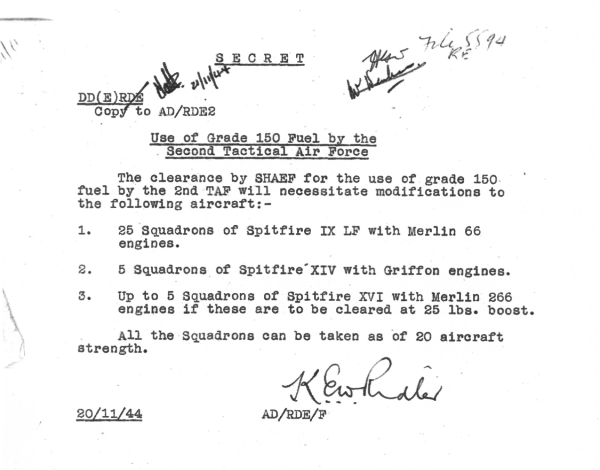
J.H Houghton Colonel A.C. Director of Supply described the supply position as of 23 November 1944:
73
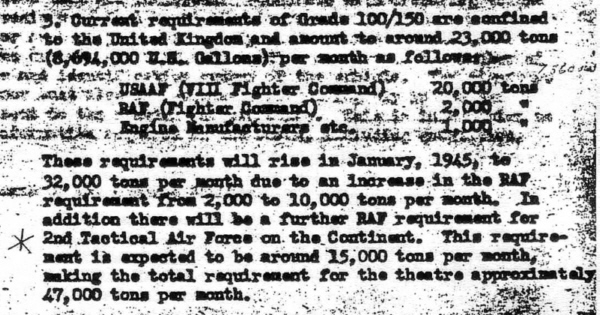
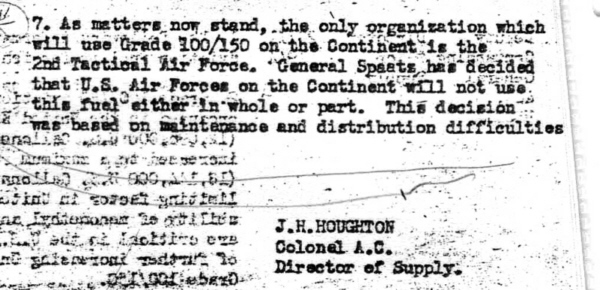
It was decided that the Second Tactical Air force would change over from 100/130 grade fuel to 100/150 grade fuel from the 15th December 1944.
74
No. 42 Maintenance Group:
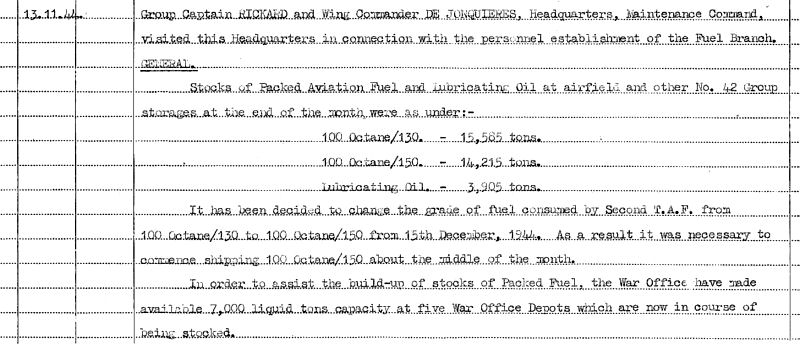
The shipping of fuel from Antwerp started on 2 January, 1945:
75
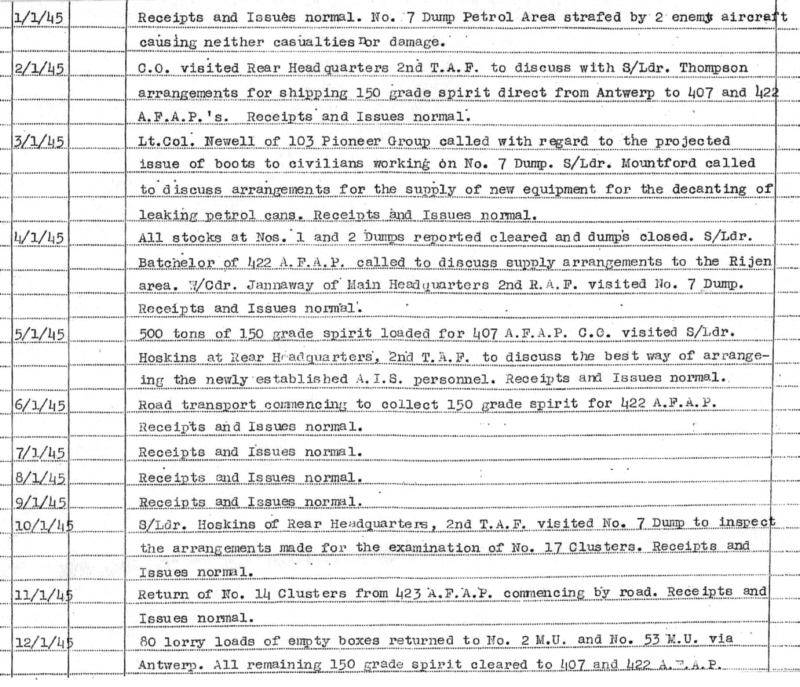
100/150 grade fuel was introduced into Spitfires of 83 and 84 Groups during January 1945:
76

On the 5 February 1945, J.H Houghton Brigadier General, U.S.A. Director of Supply, reported that the R.A.F on the Continent were using 100/150 grade fuel:
77


Deliveries continued at an increasing rate:
78

Units modified their aircraft for increased power with the change over to 150 grade fuel.
79
80
81
82
83
84
85
86
87
88
89
90
91
92
In May 1945, just days before the ultimate defeat of the Nazis, one Canadian Wing of Spitfires reverted to 130 grade fuel just in time to perform "stylish" formation shows over vanquished Germany.
93
Source References
1. Spitfire J.L.165 with Merlin 66 at 25 Lbs. Boost Pressure, Dor/Chr/RLS.1/MNH. 8.10.43
2. Spitfire IX JL.165 (Merlin 66) Trials at +25 lb/sq.inch boost with Rotol 4 blade propeller. A.& A.E.E. ref: CTO/AS.56/80. 1 February, 1944.
3. Estimated P-51B Mustang Performance with Improved Fuel (160 grade), 25 October 1943
4. Memorandum on Introduction into Service Use of 150 Grade Aviation Fuel of 25 January, 1944 (AIR 51/373)
5. Message from General Dwight D. Eisenhower, 11th February, 1944 (AIR 37/1020)
6. Message from General Henry H. Arnold, 13th February, 1944 (AIR 37/1020)
7. CTI-1509, Addendum No. 2, Program for Fuel Research, Development and Test., 21 February 1944
8. Flight Tests of Fighter Aircraft with 44-1 Fuel. 16 March, 1944
9. 75" Hg. clearance for V-1650-7. 19 April, 1944
10. Preliminary 7-1/2 Hour War Emergency Rating Test of the Allison V-1710-91 Engine Operated on Grade 104/150 Fuel
11. Attempted 7-1/2 Hr. War Emergency Rating of Allison V-1710-89 as Installed in P-38J Airplane Operated on Grade 104/150 Fuel
12. Preliminary Report of 7-1/2 Hour War Emergency Test of Pratt & Whitney R-2800-63 Engine using Power Plant Fuel 44-1
13. Performance Tests on P-38J, P-47D and P-51B Airplanes Tested with 44-1 Fuel. (GRADE 100/150), ENG-57-531-306. 15 May, 1944
14. Preliminary Flight Tests of Fighter Aircraft Using PPF 44-1 Fuel at Increased War Emergency Rating
15. Flight Tests of the North American P-51B-15 Airplane, AAF No. 43-2477 Using 44-1 Fuel. 20 May 1944
16. Flight Tests on the P-38J Airplane, AAF No. 43-28392 Using 44-1 Fuel 5 July 1944
17. Flight Tests on the P-47D Airplane AAF No. 42-26167 Using 44-1 Fuel. 15 July 1944
18. Commendation of Materiel Command Personnel in Connection with the Test Program of Grade 100/150 Fuel, 29 May 1944
19. Project P.P.F. - Installation and Operating Instructions, 20 June 1944
20. P-47D Airplane Performance Tests at 70 In. Hg. MAP, 24 June 1944
21. Message from General Bradley (POWE 33/1360)
22. Notes on 150 Grade Fuel, March/April 1944. (AIR51/373)
23. Modification of Fighter Aircraft for use of Grade 150 Fuel, Technical Instructions 28 March 1944
24. Project P.P.F., 4 April 1944
25. Memo from Bernerd F. Johnson. Colonel, Air Corps, Chief, Petroleum Section, 26 May, 1944.
26. Grade 150 Aviation Fuel, Bernerd F. Johnson. Colonel, Air Corps, Chief, Petroleum Section, 13 June, 1944.
27. 361st FG - 150 Octane Fuel delivered week ending 18 June 1944.
28. 359th FG - Engineering Report for June 1944
29. Grade 150 Aviation Fuel, 11 July, 1944:
30. Teletype Message from USSTAF to Wright Field, July 9, 1944
31. 78th FG Supply Report for December 1944
32. 78th FG Engineering Report for December 1944
33. 339th FG Aviation Fuel Report for February 1945
34. Grade 100/150 (1 ½ T) Fuel Air Technical Service Command in Europe, 28 March 1945
35. Use of 100/150 Grade Fuel by Eighth Air Force Eighth Air Force,Technical Operations, Memorandum 4 April 1945
36. Approval of 25 lbs Combat Boost on Merlin 66. 10 March, 1944. (AVIA 8/434)
37. No. 1 Squadron Operations Record Book
38. No. 165 Squadron Operations Record Book
39. Interim Report - Service Trials of Merlin 66 Engines operating at + 25lbs. Boost Pressure. 16 June, 1944. (AIR 51/373)
40. Backfire trouble resulting from use of 150 grade fuel. 27 July, 1944. (AIR 8/1226)
41. Squadrons Modified for the use of 150 Grade Fuel 12, August, 1944. (AIR 8/1226)
42. Spitfire Low Altitude Performance, +25 lbs.
43. Mustang, Tempest Low Altitude Performance, +25 lbs boost
44. Technical Note No.Aero.1501(Flight)
45. No. 316 Squadron Operations Record Book
46. No. 610 Squadron Operations Record Book
47. No. 315 Squadron Operations Record Book
48. No. 85 Squadron Operations Record Book
49. No. 157 Squadron Operations Record Book
50. No. 1 Squadron Oprep 27.8.44
51. No. 165 Squadron Oprep 16.9.44
52. 316 Squadron Operations Record Book
53. 315 Squadron Operations Record Book
54. Requisition MER/388/43., 24th August 1944
55. No. 350 Squadron Operations Record Book, August 1944
56. Packard V-1650 Engine Performance Data, 1 September 1944
57. Packard/Merlin V.1650-7 - Mustang III +25 lbs. sq./in. Boost Operation Using 150 Grade Fuel, 4th September, 1944
58. Re-rating of Engines from 18lbs to 25lbs. Boost Pressure, 6th September, 1944
59. 610 Squadron Operations Book
60. 350 Operations Record Book, September 1944
61. 130 Squadron Operations Report, 12 September 1944
62. 402 Form 541, 12 September 1944
63. 41 Squadron Operations Report, 17 September 1944
64. Use of 150 Grade Fuel, HQ ADGB, ADGB/S.37041/CTO. 18th September 1944. (AIR 51/373)
65. Grade 100/150 Fuel, J.H Houghton Colonel A.C., Director of Supply, 23 November 1944.
66. Combat Report: F/Lt. G. M. Davis, 23 March 1945, 129 Squadron
67. Combat Report: F/Lt Pearson, 5 April 45, 65 Squadron
68. 118 Squadron Operations Record Book, 8 March 1945
69. 309 Squadron Operations Record Book, 27 February 1945
70. Engines Cleared for Use of Grade 150 Fuel
71. Memo from Air Commodore F.N.Trinder, 5th August 1944. (AIR 51/373)
72. Use of Grade 150 Fuel by the Second Tactical Air Force, 20 November, 1944. (AVIA 15/2922)
73. Grade 100/150 Fuel, J.H Houghton Colonel A.C., Director of Supply, 23 November 1944.
74. No. 42 Maintenance Group ORB, November 1944. (AIR 25/616)
75. No. 424 Aviation Fuel and Ammunition Park, 2nd T.A.F. ORB, January, 1945. (AIR 29/822)
76. Modification of Merlin Engines in Night Fighter Mosquito Aircraft to Give Improved Performance, 11th January 1945. (Avia 15/2922)
77. Request for Grade 100/150 1.5 T Aviation Fuel for Eighth Air Force Units on the Continent J.H Houghton, Director of Supply, 5 February 1945.
78. No. 424 Aviation Fuel and Ammunition Park, 2nd T.A.F.(Air 29/822)
79. 401 Squadron Operations Record Book
80. 411 Squadron Operations Record Book
81. No. 126 Wing Operations Record Book
82. 421 Squadron Operations Record Book
83. 421 Squadron Operations Record Book
84. 421 Squadron Diary
85. 439 Squadron Operations Record Book
86. 438 Squadron Operations Record Book
87. 440 Squadron Operations Record Book
88. 401 Squadron Operations Record Book
89. 402 Squadron Operations Record Book
90. 442 Squadron Operations Record Book
91. F/L Georges Nadon, 403 Squadron
92. F/L W. M. Dove Logbook, 403 Squadron
93. No. 126 Wing Operations Record Book
.
Supplemental Documentation
100/150 Grade Fuel Specification
British 100/150 Grade Fuel Production
Consumption of 150 Grade Fuel (Barrels)
150 Grade Fuel Consumption by Theater (Tons)
CRD Forward Development Programme (AIR 20/1760)
352nd FG Mustang being fueled with 150-OCT GASOLINE
Crossbow Fighters Spitfire,
Mustang & Tempest, (Avia 11/15) See also Crossbow Meeting
Use of Grade 150 Fuel by the Second Tactical Air Force, 27/11/44
Use of 150 Grade Fuel by 2nd T.A.F., 26th January, 1945
Operational Notes on Merlin 63, 63A, 66, 70 and 266 Engines in Spitfire Aircraft using 150 Grade Fuel., March 1945
Merlin 66 Engine Data Card, 14-3-44
Merlin 70, 76 and 77 Engines, 31.1.45
Merlin 72 or 73 Operational Warning Card, 24.5.44
Use of Increased Combat Boost on Merlin 72 Engines, June, 1944
Ignition Timing for High Boost Running V-1650-7 & Mer. 266 Engines, 18th September, 1944
Merlin Mks. 130 and 131 - Service Approval, 25 January, 1945
Griffon 65 Auto. Boost Control-Introduction of Aneroid, Gov. Spring and Camshaft for 21 lb./sq.in. Combat Boost (Mod No. Griffon/293)
Rolls-Royce Griffon (65), Flight, September 20th, 1945
Rolls-Royce Griffon 64 and 69, 28th March, 1945
Rolls Royce Griffon 64 and 69
Griffon 64 Operating Limitations
Griffon 69 Operating Limitations
|

